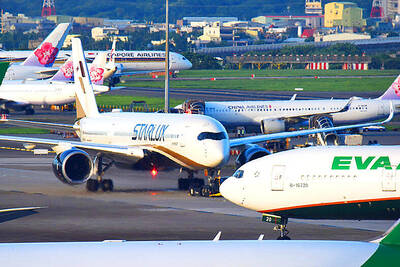Taiwan is sticking to its stance that employers should not share recruitment costs for Indonesian migrant workers as Jakarta is demanding, and would consider bringing in workers from other countries instead, the Ministry of Labor (MOL) said on Wednesday.
The ministry was responding to a letter it received last month from the Indonesian Economic and Trade Office in Taipei saying that from Jan. 1, Taiwanese employers would be required to pay 11 types of fees for Indonesian workers before they depart for Taiwan, including airfares, and passport and visa processing fees.
The letter followed a decree by Indonesian Minister of Manpower Ida Fauziyah on July 29 that allowed the resumption of recruitment and placement of Indonesian migrant workers after an eight-month suspension due to the COVID-19 pandemic.
Minister of Labor Hsu Ming-chun (許銘春) on Wednesday said that the ministry is mapping out a countermeasure, but until negotiations with Indonesia are complete, it is not appropriate to speak publicly about the matter.
Although Jakarta has asked Taiwanese employers to pay the fees, it did not say how much extra the employers in Taiwan would have to pay, Hsu said.
The labor ministry has asked for more detailed information about the terms introduced unilaterally by Jakarta and would discuss the issue with the Indonesian government, she said.
The Taipei Economic and Trade Office, Jakarta has been asked to help arrange bilateral talks, she said.
At the Taiwan-Indonesia Labor Conference in 2013, the two nations agreed that they must notify each other if they are to change their labor policy or system, and must reach a consensus through negotiations before any change is put in place, Hsu said.
“We cannot accept this,” she said, adding that if Indonesia goes ahead with the unilateral changes to the employment terms, the ministry would remind it that it should abide by the agreement reached at the conference.
The 11 types of fees Taiwan is being asked to cover include labor brokerage fees in Indonesia for caregivers, domestic workers and fishers; and the costs of labor contract verification, criminal records certificates, overseas social security premiums and overseas health checks, as well as transportation and accommodation in Indonesia prior to departure, the ministry said.
Migrant workers and workers’ rights groups have long complained about having to fully bear pre-employment costs.
The problem lies in the current hiring system, which allows brokers to charge migrant workers exorbitant fees that usually take years to repay and require loans even before the workers depart for Taiwan, the groups said.
In addition, the brokers usually side with employers to exploit migrant workers, forcing them to perform jobs that are not in their contract, migrant workers’ rights advocates have said.
As of the end of September, there were 265,553 Indonesian migrant workers in Taiwan, 194,254 of whom were employed as caregivers and domestic workers, MOL data showed.
Meanwhile, the ministry is considering allowing the recruitment of migrant workers from other countries and would ask the Ministry of Foreign Affairs to provide a list of such nations based on its assessment of national security and diplomacy, Hsu said.

The disruption of 941 flights in and out of Taiwan due to China’s large-scale military exercises was no accident, but rather the result of a “quasi-blockade” used to simulate creating the air and sea routes needed for an amphibious landing, a military expert said. The disruptions occurred on Tuesday and lasted about 10 hours as China conducted live-fire drills in the Taiwan Strait. The Civil Aviation Administration (CAA) said the exercises affected 857 international flights and 84 domestic flights, affecting more than 100,000 travelers. Su Tzu-yun (蘇紫雲), a research fellow at the government-sponsored Institute for National Defense and Security Research, said the air

Taiwan is to commence mass production of the Tien Kung (天弓, “Sky Bow”) III, IV and V missiles by the second quarter of this year if the legislature approves the government’s NT$1.25 trillion (US$39.78 billion) special defense budget, an official said yesterday. Commenting on condition of anonymity, a defense official with knowledge of the matter said that the advanced systems are expected to provide crucial capabilities against ballistic and cruise missiles for the proposed “T-Dome,” an advanced, multi-layered air defense network. The Tien Kung III is an air defense missile with a maximum interception altitude of 35km. The Tien Kung IV and V

Trips for more than 100,000 international and domestic air travelers could be disrupted as China launches a military exercise around Taiwan today, Taiwan’s Civil Aviation Administration (CAA) said yesterday. The exercise could affect nearly 900 flights scheduled to enter the Taipei Flight Information Region (FIR) during the exercise window, it added. A notice issued by the Chinese Civil Aviation Administration showed there would be seven temporary zones around the Taiwan Strait which would be used for live-fire exercises, lasting from 8am to 6pm today. All aircraft are prohibited from entering during exercise, it says. Taipei FIR has 14 international air routes and

Taiwan lacks effective and cost-efficient armaments to intercept rockets, making the planned “T-Dome” interception system necessary, two experts said on Tuesday. The concerns were raised after China’s military fired two waves of rockets during live-fire drills around Taiwan on Tuesday, part of two-day exercises code-named “Justice Mission 2025.” The first wave involved 17 rockets launched at 9am from Pingtan in China’s Fujian Province, according to Lieutenant General Hsieh Jih-sheng (謝日升) of the Office of the Deputy Chief of the General Staff for Intelligence at the Ministry of National Defense. Those rockets landed 70 nautical miles (129.6km) northeast of Keelung without flying over Taiwan,